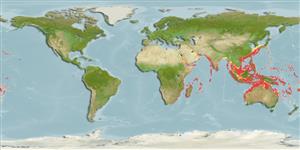Environment / Climate / Range
Ecology
Marine; freshwater; brackish; demersal; catadromous (Ref. 51243); depth range 20 - 350 m (Ref. 58488). Tropical; 26°C - 29°C (Ref. 4959), preferred ?; 36°N - 35°S, 20°E - 167°W
Indo-Pacific: Red Sea and East Africa to Samoa, north to southern Japan, south to the Arafura Sea (Ref. 9819), Australia, and Lord Howe Island.
Length at first maturity / Size / Weight / Age
Maturity: Lm 13.0, range 9 - 17 cm
Max length : 36.0 cm TL male/unsexed; (Ref. 9710); common length : 25.0 cm SL male/unsexed; (Ref. 4967)
Dorsal
spines
(total): 11 - 12;
Dorsal
soft rays
(total): 9-11;
Anal
spines: 3;
Anal
soft rays: 7 - 10. Lower opercular spine extending well beyond the opercular flap. Post temporal bone exposed posteriorly and serrate. Body color is fawn above, cream below, nape dark; head, body and fins with and iridescent sheen. Three or four curved dark brown bands run from the nape to the hind part of the body, the lowermost continuing across the middle of the caudal fin.
Found over shallow sandy bottoms, in the vicinity of river mouths. Enter estuaries and rivers (Ref. 1479, 11230, 44894, 48635). Adults in loose aggregations (Ref. 48635). Juveniles common in sandy intertidal areas; often in tidal pools. Minimum depth reported is 20 m (Ref. 12260). Found in schools (Ref. 9710). Omnivorous (Ref. 7300), feeding on fishes, insects, algae, and sand-dwelling invertebrates (Ref. 9710). Spawn in the sea and juveniles migrate into fresh water (Ref. 2847). Eggs are guarded and fanned by the male parent (Ref. 205). Produce sound (Ref. 9137). Marketed fresh, dried or salted (Ref. 12693).
Eggs are guarded and fanned by the male parent (Ref. 205).
Paxton, J.R., D.F. Hoese, G.R. Allen and J.E. Hanley, 1989. Pisces. Petromyzontidae to Carangidae. Zoological Catalogue of Australia, Vol. 7. Australian Government Publishing Service, Canberra, 665 p. (Ref. 7300)
IUCN Red List Status (Ref. 115185)
CITES (Ref. 94142)
Not Evaluated
Threat to humans
Harmless
Human uses
Fisheries: minor commercial; aquaculture: commercial
Tools
Special reports
Download XML
Internet sources
